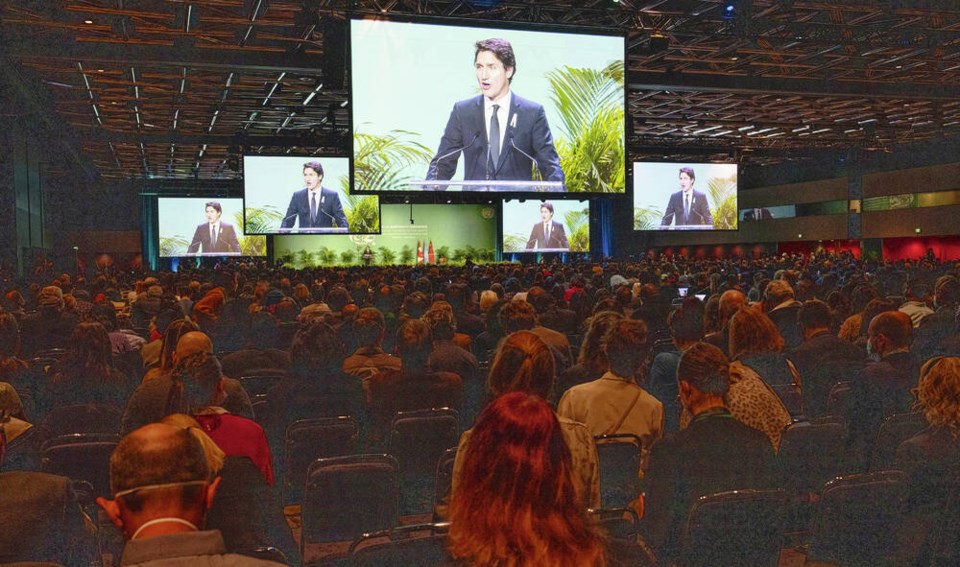“Reconciliation between Aboriginal and non-Aboriginal Canadians, from an Aboriginal perspective,” wrote the Truth and Reconciliation Commission in 2015, “also requires reconciliation with the natural world. If human beings resolve problems between themselves but continue to destroy the natural world, then reconciliation remains incomplete.”
As commissioners, they added, “this is a perspective that we have repeatedly heard: that reconciliation will never occur unless we are also reconciled with the earth.”
That astute observation is particularly pertinent as the nations of the world meet at COP15 in Montreal to negotiate a new Global Biodiversity Framework. A prominent theme going into the negotiations has been the role of Indigenous people in protecting and enhancing biodiversity, something the UN has been emphasizing for several years.
In a speech on the state of the world in December 2020, UN Secretary General Antonio Guterres spoke specifically to the importance of Indigenous people as protectors of nature, calling on nations to “heed their voices, reward their knowledge and respect their rights.”
The rights of Indigenous Peoples with respect to their traditional lands, territories and resources are addressed in a number of articles (especially articles 25-29 and 32) in the UN Declaration on the Rights of Indigenous Peoples, which both sa╣·╝╩┤½├Į and sa╣·╝╩┤½├Į have recognized and adopted into legislation.
Pointing out that “Indigenous Peoples make up less than 6 per cent of the world’s population yet are stewards of 80 per cent of the world’s biodiversity on land,” Guterres noted that “nature managed by Indigenous Peoples is declining less rapidly than elsewhere.”
Thus, he suggested, “Indigenous knowledge, distilled over millennia of close and direct contact with nature, can help to point the way” toward protection of nature.
His remarks were rooted in a number of UN agency reports, including 2019 reports from the Intergovernmental Science-Policy Platform on Biodiversity and Ecosystem Services, the UN Department of Social and Economic Development Affairs and the UN Environment Program’s Global Environment Outlook, as well as the 2020 Human Development Report, all of which stressed the importance of Indigenous knowledge and approaches.
With COP15 being held in Montreal, headquarters of the Secretariat for the Convention on Biodiversity, sa╣·╝╩┤½├Į is not surprisingly playing a leading role.
At the opening ceremony, Prime Minister Justin Trudeau joined the call by the U.K., France and Costa Rica to conserve 30 per cent of the Earth’s land and waters by 2030. He claimed sa╣·╝╩┤½├Į is on track to protect 25 per cent by 2025 and that 30 per cent by 2030 is “quite feasible.”
In an accompanying statement, Trudeau noted “Indigenous Peoples have been caring for the lands and waters of sa╣·╝╩┤½├Į since time immemorial” and that they “have unique relationships with nature and knowledge of responsible stewardship as a way of life.”
He announced $800 million over seven years, starting in 2023-24, to support up to four large-scale Indigenous-led conservation initiatives in sa╣·╝╩┤½├Į’s North. sa╣·╝╩┤½├Į has also just created the First Nations Guardian Network — a world first — to support Guardians in stewarding and monitoring their territories.
Which all sounds good, except that there are questions about what “protection” really means, and the potential impacts on Indigenous Peoples. A Dec. 8 article in The Narwhal reports that Trudeau revealed in an interview that “some resource extraction may be allowed in conserved areas.”
Presumably that is what prompted James Snider of World Wildlife Fund sa╣·╝╩┤½├Į, in the same article, to ask “what do we mean by protected and conserved areas?” while Charlotte Dawe of the Wilderness Committee comments that she has “stood in freshly logged ‘protected areas’ supposedly made for the conservation of wildlife.”
That hardly equates to protection.
Moreover, the protection of nature must not come at the expense of Indigenous people, a point stressed by the International Indigenous Forum on Biodiversity as well as by three UN special rapporteurs on human rights.
Both groups are concerned that in the rush to protect nature, the human rights of Indigenous people may be violated. Indeed, Indigenous people have been evicted or threatened with eviction from “protected” areas, in the Democratic Republic of the Congo, Tanzania and Nepal.
So not only must reconciliation include the Earth, it must also — of course — include reconciliation with Indigenous Peoples in sa╣·╝╩┤½├Į and around the world.
Dr. Trevor Hancock is a retired professor and senior scholar at the University of Victoria’s School of Public Health and Social Policy.



